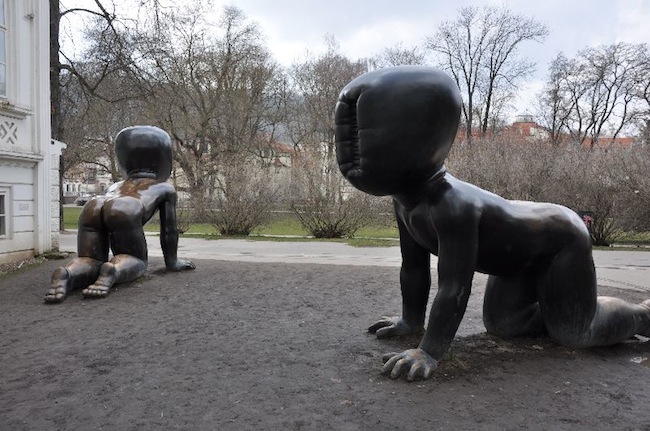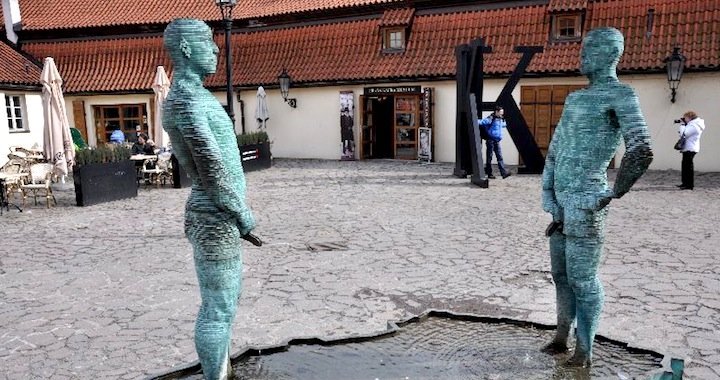
The Bad Boy of Czech Art
An interview with David Cerny
The British newspaper The Guardian once called the Czech sculptor/showman, David Cerny, a cross between Antony Gormley and Damien Hirst. There certainly is a grain of truth to it. Cerny is a part of Prague's mythology. In a sense, he's even become one of its features – daily, tourist groups are led along the paths lined by his urban sculptures. Cerny is famous for his sarcastic comments aimed at the political elite, as well as for his works, which are like an awl – they may not be able to cardinally change anything, but they constantly poke and churn the socio-political waters, preventing us from sinking into conformism.
His most popular sculpture among the tourists is “Piss” (2004), which stands across from the Kafka Museum. Two green, mechanical men made of bronze move their metal “members” with robotic enjoyment as they urinate over a map of the Czech Republic. This is an ironic nod to Brussels' “Urinating Boy”, as well as to the still ever-present urinating in public places that is so characteristic of Eastern European cities – which is, notably, attributable to the British tourists who go there to celebrate their bachelor parties and who have chosen to relieve themselves on memorials of national importance. Upon taking a closer look, one notices that the stream of water hitting the pool is actually forming barely legible letters. Both of the “tools” of the metal men can programmed by text message. Basically, send a text and the sculpture will “write it” in the water.
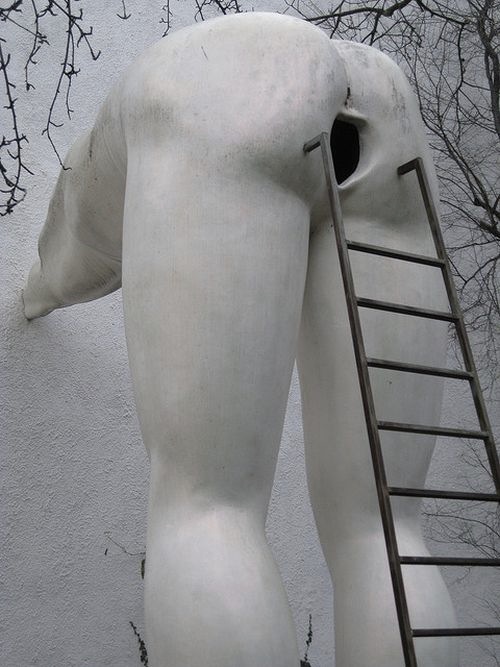
Futura. 2003
One of Cerny's most controversial sculptures, however, is on the lawn of Prague's Futura gallery – “Futura” (2003) is a gigantic, white human bottom equipped with a video monitor; you can see the monitor by climbing up a ladder that is propped up between the sculpture's legs. The video shows the now ex-president of the Czech Republic, Vaclav Klaus, and the one-time director of Prague's National Gallery, Milan Knižak: in the style of “you scratch my back, I'll scratch yours”, they feed one another slop, with Queen's “We Are the Champions” playing in the background.
Cerny has a special relationship with Knižak – during the setting up of the exhibition for the Chalupecky Prize (established in 1990 by Vaclav Havel, and awarded to young Czech artists under 35), the two had a heated argument and Cerny was removed from the premises by security. The culmination of this incident was when – to everyone's great surprise – Cerny was awarded the prize. The award ceremony was held at the National Gallery, but since Cerny had declined to set his foot inside of it, he organized a picnic on the lawn. Vaclav Havel, who was president at the time and understood jokes, presented the award. So, if Mohamed won't go to the mountain, then the mountain will go to Mohamed... And the president went out to the artist.
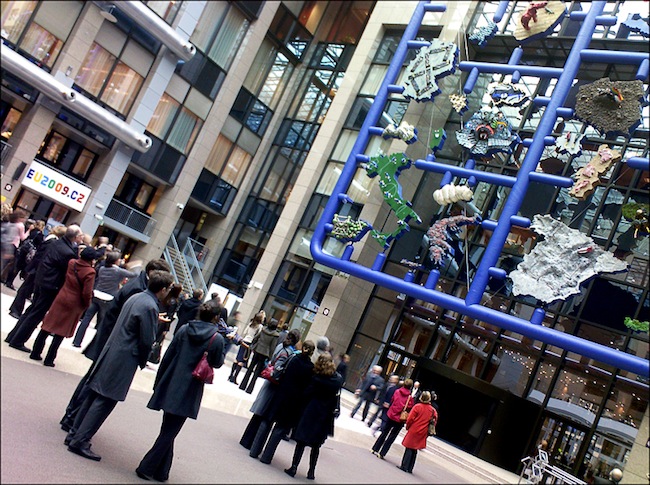
Entropa. 2008
Cerny's most talked-about piece, however, is undeniably “Entropa” (2008); he isn't too keen on speaking about the subject anymore – it's already been rehashed too much. When the Czech Republic was preparing to take on the presidency of the Council of Europe, Cerny was asked to create an object of art which would be displayed in Brussels' Justus Lipsius building during the tenure of the Czech Republic. His idea was to create a gigantic collage of all of the European countries, with a different artist from each country creating the image for their home country. Keeping the real process hidden until the very last moment, Cerny and two colleagues had created an ironic and brightly directed mystification.

Instead of working with 26 individual artists, fake ones were made up – with resumes, and even homepages. The truth was revealed only when the installation was exhibited in Brussels. “Entropa” was a grotesque caricature – based on cliches and stereotypes. Italy was portrayed as a football field with masturbating players; Belgium was a half-eaten box of chocolates; the Czech Republic was a LED screen, blinking with the most controversial statements uttered by its then-president; and Bulgaria was an illuminated “Turkish” squatting toilet. Consequently, Bulgaria raised a diplomatic furor, resulting in its part of the installation being covered with black cloth. Later, in apologizing to the government, Cerny wrote: “We new that the truth would come out. But before that happened, we wanted to see if Europe is able to laugh at itself.”
Actually, Cerny had already garnered international attention in 1991, when he and some friends painted a Russian tank pink – the tank had been placed in the Smichov neighborhood in 1945, in commemoration of the Soviet Army marching into Prague. The painting of the tank took place at 5 AM, and the group had armed themselves with forged letters – from the City Council and the Film Academy – in case the police showed up. Later, in acknowledgment of the piece of art, Cerny even signed the tank. The sensational escapade worked – people collected signatures on the street for petitions, and some quick-thinking marketing hot-shots even managed to print up t-shirts.
Putting the extravagant persona aside, Cerny simply calls himself a sculptor, and instead of theorizing about art, he'd much rather talk about another of his passions – getting a professional pilot's license; he already has a license to pilot his Cessna 172.
Sculptures Baby in Kampka Park, Prague
Cerny graduated from Prague's Academy of Arts, Architecture and Design, and with support from the Soros Fund, he lived in an artist's residence in New York for a year. In 1994, Chicago's Museum of Contemporary Art held an exhibition featuring Eastern European art – “Beyond Belief” – in which Cerny's first “baby mutant”, the sculpture “Baby”, was shown. Now there's a whole group of them. Three loll in Kampka Park, in front of the white facade of Museum Kampka. Ten more crawl up the Žižkov Television Tower.
Hanging Out. 1996
And in the city's old center, Sigmund Freud, hand in pocket, hangs by the other hand from a beam jutting out from the roof of the Art History Institute (“Hanging Out”, 1996).This piece, copies of which have been shown in art centers the world over, is often interpreted as Cerny's vision about the role of intellectuals in the new millennium. But it is just as possible that it is just Freud looking down upon the world and its helplessness. Ironically, since most people walk with their eyes on the cobblestones in front of them, instead of looking up at the sky, they don't even notice the sculpture that hangs above their heads.
For last year's Olympic Games in London, Cerny created the sculpture “London Booster” – a classic, double-decker bus from 1957, tricked-out as a fit athlete with huge, red arms of metal – and it even grunts and pants as it does pushups. It should be mentioned that in one of his interviews, the artist didn't forget to point out that, in addition to pushups being a universal form of training, they are also used as a form of punishment for prisoners and soldiers.
Meetfactory's facade and entrance
One of the most ambitious of Cerny's current projects, and which has also changed the cultural landscape of Prague, is Meetfactory. It's an alternative cultural center that contains an exhibition hall, rooms for music, theater and film projects, artist studios and residencies. And it's located in the middle of nowhere – in the city's industrial center, the Smichov neighborhood. Right next to it are train tracks and a freeway, and it can be identified by its seemingly dripping green and white facade, as well as by the red cars that are attached to it (Cerny's installations). The idea took seed as soon as he returned from New York. “If there are places like this in New York and Berlin, then why not in Prague?” The name of the center is a play on the words “meet” and “meat”, because the building in which the project began once belonged to the Prague Ham Factory. Things didn't work out on the first try, however; but Cerny didn't give up. “In 2005, the City Council had about ten buildings that were in terrible condition, completely destroyed. Not knowing what to do with them, they were offered to non-profit organizations; I requested one – the one that no one else wanted. They called me crazy. But I said that I would do it. We don't make anything off of this project. All proceeds from the events that take place here are invested back into Meetfactory. A third of our expenses are covered by a grant (the Ministry of Culture also gave us a small one), and two thirds come from us – from our supporters, from our own finances.” Currently (through 24 April), Meetfactory is exhibiting a show/dedication to political art in Russia – “Pussy Riot and Russian Tradition of Art Rebellion” – which centers on the processes in Russian art over the last 30 years. Among the participants are such notable names as Oleg Kulik, the group Gnezdo, and “The Blue Noses”. Curating the exhibition is Andrey Erofeev, who is well-known in Russia.
Although opinions on Cerny may be divided – such as labeling his works as “happenings” and accusing him of going for shock value rather than artistic value – his “scars” on the face of the city are so pronounced that one can barely imagine today's Prague without them. And there can't be many cities in the world where the works of a living artist have become an intrinsic part of the tourism industry.

Prague's enfant terrible David Cerny. Photo: Hynek Glos
Meeting the artist in the cafe Kavárna Mlýnská, which he calls his living room, Cerny's always-tousled mop of hair, disarming smile and air of unveiled irony and frivolity invoke a distant similarity to Mick Jagger (a stereotype, of course). They also happen to share a weakness for women. Cerny speaks directly, unhindered by political correctness, and doesn't abandon his image of a “bad boy” for even a second.
Why did you return to Prague after spending time in New York?
I had to. And I am a Praguer.
If you could choose to live anywhere, would you choose Prague?
I want to get a professional pilot's license, and if I do, then I will drop everything and become a pilot somewhere in Africa.
Is that really your plan, or is that just a plan that you have today?
No, I'm serious. For three years now, whenever I have free time or a holiday, I try to prepare for the pilot's license exam.
But can't you already pilot your Cessna now?
Yes, but to pilot large planes, I need to finish school.
You want to pilot a Boeing?
Yes, then I'll be able to pilot a Boeing.
That's your goal?
The goal is to get away from here. To be a pilot somewhere in southern Africa or America. Yes, South America would be better (laughs).
In spite of all this, you're still in Prague. What is it that you like here?
This bar. Some of my peers. Some girlfriends. There's some sort of pleasant feeling about Prague that I missed when I was in New York. Some sort of mystery about the city. You can leave a bar at 3 AM and walk through a completely empty city. It's unbelievable that there still are places like that in this world.
What do you hate about Prague?
In the last few years, it's the preposterous politicians who are, in large part, ruining the city. The massive corruption that rules everywhere. The massive amount of rich Russians who come here and ruin Prague in a mental way. Compulsory for their kind of set are the very biggest and most expensive automobiles, and all that kind of shit... They lower the standards for civil relationships. The Russian occupation, which we had hoped was over, has started its second wave. And if we take money into consideration, then this one is even more serious than the first one. And with the newly-elected president, who is very pro-Russian, it's just getting worse.
From this point of view, a pilot's license sounds like a good idea...
Yes, it's a very good thing. Because you never know when you'll need to quickly jump in a plane and run away...
Aren't you a bit tired of these constant labels attached to you – provocateur, rebel, enfant terrible, etc.?
I don't use this bulls**t about me...
But almost every interview with you starts with a description like that... In walking around the city today, I watched as a tourist guide was describing to his group your statue by the Kafka Museum, in which two men urinate on a map of the Czech Republic, and I got the feeling that your art has become, in a certain sense, a stop for tourists in Prague.
What can I say... None of these pieces that are on view in the city actually belong to the city. The statue that you mentioned, “Piss”, is on private property.
Does this mean that all of these works still belong to you?
Yes, except for one which belongs to a friend of mine. In terms of political freedom or freedom of art – you can say what you want.
You've never had any problems?
If I worked for the government, then it might be different. But I don't work for the government.
Now, a slippery subject – about how your piece, “Entropa”, sometimes creates conflict even on an international scale. Do artists have the right to work with issues that could become diplomatic scandals? Or should one allow an inner form of censorship to exist?
I can't do illegal things, like be an open pro-Nazi that promotes Nazi symbolism and Nazism. Besides that, I can do whatever I want.

Saddam. 2005
One of your most scandalous pieces is a parody about Damien Hirst's legendary shark – your “Shark” (2005) is Saddam Hussein in a tank of formaldehyde. What made you want to create a work like this, and what was the message that you wanted to send?
That was almost ten years ago, when I was invited to participate in Prague's first so-called art biennale. The previous year I had been in Baghdad, working as a camera man. This was my reaction to the whole situation in Iraq: the American invasion; the Iraqis who didn't feel as if they had been freed, but as if they had been occupied; a controversial image of a dictator. In addition, Hussein hadn't yet been captured at the time. Later, with the help of the media, he was made into a monster, into something like a dangerous animal. I had two ideas at first, but I only had two weeks' time before the biennale, and the first idea was very complicated to carry out. And then I decided – just fake it... So, that's the story.
Geographically, Prague is right in the center of Europe. But in terms of art – is it a metropolis, or is it a backwater?
No, it's still a backwater.
How can that be changed?
It can't. At least not during my lifetime.
Why not? Is it because the Western art market constantly continues to ignore Eastern Europe?
No; it's because Prague is simply provincial. For forty years the country was under the communist regime; the greater part of the intelligentsia was killed, weeded out, destroyed in the gas chambers. You simply can't expect anything special from this kind of a country.
Is there really no one emerging from the new generation? New names, powerful ideas?
Perhaps. But the surroundings remain the same. We are not Berlin, Dresden, or Vienna. That's reality. Sorry about that.
Are you saying that the environment suppresses any creative initiatives?
There is no support from the private sector, or from the state sector. In terms of the mental sector – nothing is coming from the nation's leaders. What can we do, what sort of development can we expect with the kind of president that has just been elected?
In your opinion, is your art nationalistic, or is it cosmopolitan?
I work.
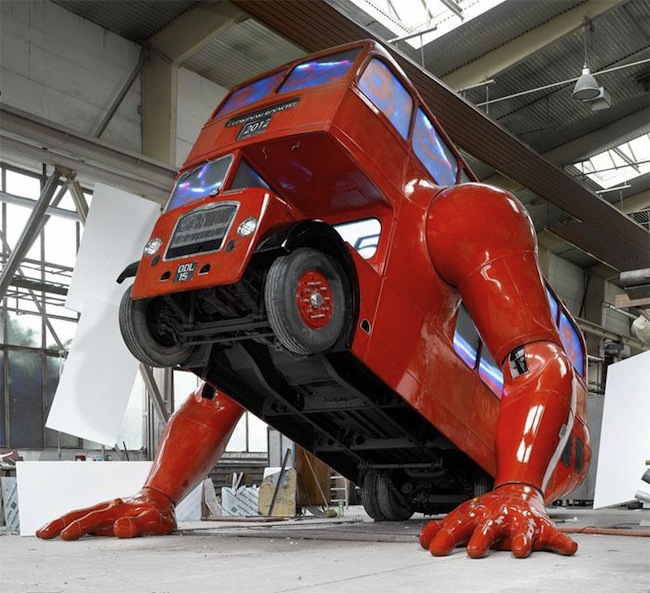
London Booster. 2012
But at the same time, you are undeniably the most famous of the current crop of Czech artists... Your work was part of London's Olympic Games.
No; if you were to ask any of the local art critics, I wouldn't even be on their list. But I don't worry too much about that.
Maybe that's a characteristic of the Czech mentality?
Yes, yes. We're a completely fu**ed-up nation. Look at the election results.
Are they much worse than the previous ones?
It's hard to tell... It's hard to tell which one is the biggest disaster. This one is a heavy drinker and – as a really heavy drinker – he might collapse very soon. That's one side. In addition, he's more of a typical Czech than the previous president was. A vodka drinker and a potato dumpling eater. If you were to ask him what art is, I don't think he'd even know what art means. Ten years ago, when he was the prime minister, he said that I'm corrupting the next generations, and that I should be in prison. That was the headline of the largest Czech newspaper. One could say, prison is yearning for Cerny...
Are you politically active? For instance, did you vote?
Yes, I participated in the election.
What do you do that is politically active, or maybe you're not that active after all?
Sometimes I answer journalists' questions.
Can't you influence anything as an artist? And as a well-known artist, at that?
Maybe – if I truly decided to do something and then fled the country. I'd make sure my plane is ready, and then I'd take a weapon and kill somebody, then head to the airport and escape. Then, perhaps, I'd be politically active.
In one interview, you said that anger is an excellent source of inspiration.
Sometimes, yes; when I'm not tired...
Art theoreticians have yet to agree on a definition for the term “contemporary art”. What would be your version?
You know... I don't even want to talk about it.
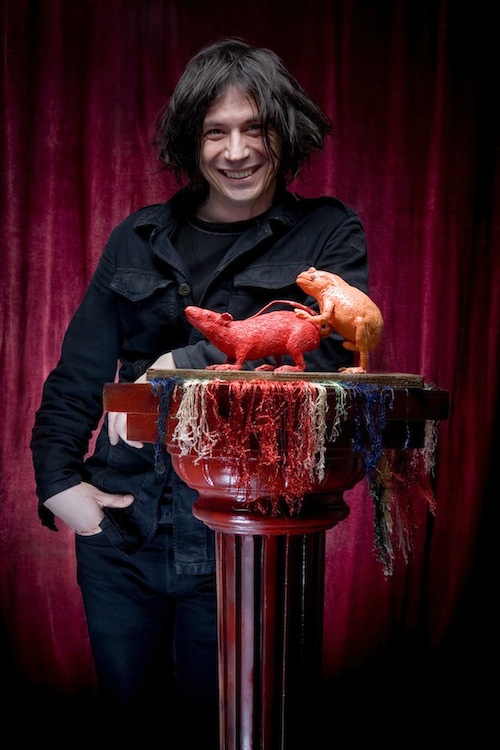
David Cerny
How important to you are the people who view your art?
This is a good question... Of course, the correct answer would be that the ones with the most importance are the ones who pay for it. But I've never been in this kind of situation. If I had been, then I definitely would have sold something more to the city (laughs). How important? In kilograms, or in liters?
Liters.
350. Is that enough? I think it's enough.
Duchamp once said about his famous “Nude” – that by having too many people looking at it, it transformed from a scandalous painting to a boring painting. Do you ever feel the same way, in terms of your public pieces of art?
He has already said it all.
You can dispute how well-known, famous and acknowledged you are or aren't, but there can't be that many cities in the world where the works of an artist have become a part of the tourism industry.
Gaudí, in Barcelona.
Gaudí is dead, but you're still alive.
Yes, that's a valid argument. But I didn't organize that.
If I came and put the money in front of you, and said that I want to buy all of your sculptures, would you sell them?
No, these things are not for sale.
That means that you are a little bit of a Prague patriot, after all.
I am not a patriot, but I live here. I've grown up here.
Let me know when you get your pilot's license and start to fly.
… right, so that you don't board that plane by mistake.
What is the joy in flying?
I think it is a freedom that you cannot get in any other way.
